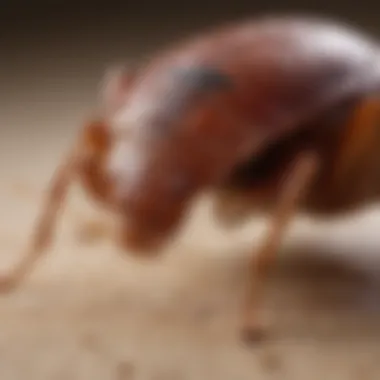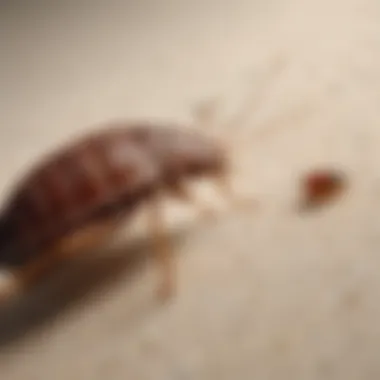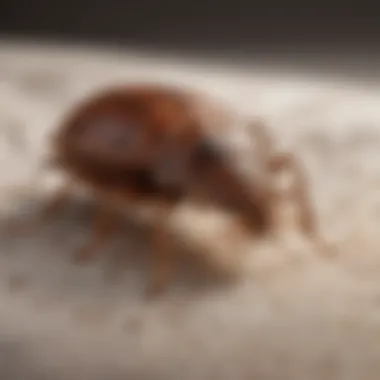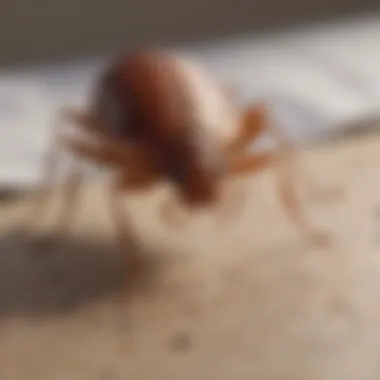Understanding Bed Bug Bites: Symptoms and Treatment


Intro
Bed bug bites can pose a perplexing challenge for homeowners. These small nocturnal pests, known scientifically as Cimex lectularius, often escape detection until their presence becomes a significant nuisance. This article delves into the complexities of bed bug bites, facilitating a clearer understanding of their characteristics and the body’s reaction to such bites. This foundational knowledge equips readers with the necessary tools to identify the issue promptly, effectively manage infestations, and mitigate future occurrences.
Understanding the Pest
Identification
Identifying bed bugs is critical for homeowners aiming to address potential infestations. Adult bed bugs are roughly the size of an apple seed, approximately 4 to 5 millimeters long. They possess a flat, oval shape, which helps them hide in tiny cracks and crevices during the day. The coloration of an adult bed bug typically ranges from reddish-brown to tan, depending on whether they have recently fed.
Key indicators of a bed bug presence include:
- Bites: Typically appear in clusters or lines on the skin
- Fecal stains: Small dark spots on bedding or furniture
- Shell casings: Become noticeable as the bugs mature
- Odor: A sweet, musty scent may be present in heavily infested areas
Life Cycle
Understanding the life cycle of bed bugs assists in comprehending their ability to proliferate. The bed bug undergoes five nymphal stages before reaching adulthood, with each stage requiring a blood meal to molt to the next.
Their life cycle can be summarized as follows:
- Egg: A female bed bug can lay around 200 to 500 eggs in her lifetime.
- Nymph: Hatching within a week, nymphs are smaller and lighter in color than adults.
- Adult: After 5 molts, nymphs mature into adults within about 5 weeks, capable of reproduction.
The entire cycle from egg to adult typically takes about 6 to 10 weeks, depending on environmental conditions.
Pest Prevention Strategies
To manage bed bug infestations, an emphasis on prevention is crucial. Homeowners should focus on modifying their environment to deter these pests.
Environment Modification
Reducing clutter around the home can minimize hiding spaces for bed bugs. Regularly washing bedding and vacuuming floors, particularly in areas where these pests are likely to inhabit, can help to eliminate potential breeding grounds.
Physical Barriers
Physical barriers can include:
- Bed bug encasements: Protective covers for mattresses and pillows
- Seal cracks and crevices: This prevents bugs from entering the living spaces
- Laundry precautions: Washing clothing and linens on high heat can kill any eggs or live bed bugs
Control Methods
Despite the best preventive measures, control methods may be necessary if an infestation occurs.
Chemical Control
Chemical treatments can effectively eliminate bed bugs once they are identified. Common products may include pyrethrins and neonicotinoids, but their application requires caution to ensure safety and effectiveness. Always follow manufacturer instructions.
Biological Control
Biological methods offer a more eco-friendly alternative. Utilizing natural predators, such as certain species of insects, can help control bed bug populations without the use of synthetic chemicals.
"The key to managing bed bug infestations lies in understanding both the pest and the environment in which they thrive."
Approaching the challenge with a comprehensive strategy that includes both prevention and control is essential for effective bed bug management.


Through awareness and diligent practices, homeowners can address and contain these unwelcome visitors, ensuring a more comfortable living space.
Prolusion to Bed Bugs and Their Bites
Bed bugs are small, elusive pests that have become a growing concern for many households. Understanding bed bugs and their bites is essential for both prevention and treatment. This section sets the foundation for comprehending how these pests operate and the effects they have on those unfortunate enough to be bitten. Learning about bed bugs is particularly vital for housewives and homeowners who may encounter infestations in their living spaces.
Overview of Bed Bugs
Bed bugs, scientifically known as Cimex lectularius, have been a nuisance for centuries. These insects are notorious for their ability to thrive in various environments, primarily in places where humans reside. Adult bed bugs are about the size of an apple seed, making them difficult to see. They exhibit a flat, oval shape which allows them to hide easily in cracks and crevices during the day.
Bed bugs feed primarily on human blood. Their bites can lead to itchy welts and other symptoms. These pests are not known to transmit diseases, but their presence can cause significant distress and discomfort for their victims.
Understanding Bed Bug Behavior
Understanding bed bug behavior is essential to effectively manage and prevent infestations. Bed bugs are primarily nocturnal and will emerge at night to feed. They are attracted to the heat and carbon dioxide produced by sleeping humans. Once a location becomes infested, bed bugs can reproduce rapidly, making early intervention crucial.
The habits of bed bugs are also influenced by their environment. They prefer dark and secluded places, often hiding in bedding, furniture, and baseboards. They can survive long periods without feeding, which makes eliminating them particularly challenging.
The combination of their stealthy nature and rapid reproductive capabilities contributes to their status as persistent pests in homes and establishments.
Identifying Bed Bug Bites
Identifying bed bug bites is a crucial aspect of managing encounters with these pests. Understanding how to recognize the unique characteristics of bed bug bites can help individuals respond quickly and effectively, reducing the chance of exacerbating a potential infestation. Early identification of bites can inform the necessary steps to eliminate bed bugs and also avoid misdiagnosing the bites for other common insect encounters.
Physical Characteristics of Bed Bug Bites
Bed bug bites display distinct physical characteristics. Typically, bites appear as small, red welts that may vary in size. The bites often appear in clusters or linear patterns, which is a key identifying feature. It is also common for bites to be intensely itchy. Some individuals might experience more pronounced reactions, manifesting as larger swollen areas around the bite. Understanding these visual markers is essential as they help differentiate bed bug bites from those of other insects.
Additionally, unlike mosquito bites which tend to be just a single welt, bed bug bites can occur in groups of three or more. This specific documentation of appearance offers critical insight when assessing suspected infestations.
Common Locations of Bites on the Body
Bed bug bites typically occur on exposed skin. Common areas include:
- Arms
- Neck
- Face
- Legs
- Shoulders
Bites on the arms and legs are particularly prevalent due to these areas being more exposed while sleeping. Locations on the face and neck may indicate that the individual has been sleeping in a position more favorable to the bugs’ access. Awareness of these common locations helps in identifying the source of irritation and subsequently taking action in pinpointing bed bug presence.
Differentiating Bed Bug Bites from Other Insect Bites
It is essential to differentiate bed bug bites from other insect bites, as many people can confuse them with those from mosquitoes, fleas, or other pests. Here are key strategies to make this identification:
- Appearance: Compare the bite's appearance. Bed bug bites are often red with a darker center, while mosquito bites are usually more uniform in color.
- Pattern: Notice the pattern of the bites. As mentioned before, bed bug bites often appear in a row or cluster.
- Itching: Assess the level of itching. Bed bug bites are generally more pruritic than those from many other insects.
- Location: Evaluate the common locations, as bed bug bites favor exposed skin on parts of the body that are frequently covered by bedding during sleep.
Physiological Reactions to Bed Bug Bites
Understanding the physiological reactions to bed bug bites is essential. This section provides insights into how the body responds when bitten. Recognizing these reactions can aid in quicker identification and management of infestations. Additionally, an awareness of these symptoms can help individuals decide when to seek medical assistance.
Immediate Reactions and Symptoms
Upon being bitten by a bed bug, the body often displays immediate reactions. Commonly, individuals experience redness and swelling at the bite site. This reaction is a response to the saliva injected by the bug, which contains specific proteins. These proteins can cause an inflammatory response.
Some people may also feel a burning or itching sensation. These symptoms can vary significantly between individuals. Factors such as skin sensitivity and previous exposure to bed bugs play a role. In some cases, small raised welts may form, indicating a stronger reaction. Immediate care can involve applying cold packs to alleviate swelling and using over-the-counter antihistamines for itching.


Delayed Reactions and Allergic Responses
In addition to immediate symptoms, some people may experience delayed reactions to bed bug bites. This can occur days after the initial bite. These delayed responses may include increased itching or the development of larger welts. Allergic reactions can manifest as hives, rashes, or other skin irritations.
For those with more severe allergic responses, symptoms might extend beyond the bite area. They may include difficulty breathing or swelling of facial structures. It is noteworthy that a person's immune response can shift over time. A person who previously experienced mild reactions may develop more severe ones with future encounters. Consulting a healthcare professional is advisable if severe allergic symptoms occur.
Early detection and treatment are crucial. Recognizing both immediate and delayed reactions can significantly improve management strategies and reduce the discomfort related to bed bug bites.
Visual Documentation of Bed Bug Bites
Visual documentation plays a crucial role in understanding bed bug bites. It allows individuals to clearly identify the characteristics and severity of these bites. The presence of visual evidence helps in distinguishing bed bug bites from those of other insects. Furthermore, it aids in better communication with pest control professionals. By having a visual reference, homeowners can provide detailed descriptions of their situation. This fosters more effective pest management strategies.
Photographic Evidence of Bed Bug Bites
Photographic evidence gives a clear view of the physical appearance of bed bug bites. Such images show the typical red welts that appear on the skin. These bites often manifest in clusters or lines, a unique sign that differentiates them from other insect bites. For example, you may notice multiple bites in a straight line, indicating the feeding pattern of the bed bug. These visuals help in educating the public. They can serve as a vital resource for individuals to assess their own situations.
Images can also illustrate the varying degrees of reaction to bites. Some people may have mild reactions, while others can experience severe allergic responses or secondary infections due to scratching. Understanding these differences through images helps raise awareness about the potential health implications of bed bug bites and the importance of seeking treatment when necessary.
Analyzing the Severity of Bites through Images
Analyzing the severity of bed bug bites through images can provide significant insights. It is essential to note that photographs can reveal more than mere appearance. They can also indicate the progression of reactions over time. Initially, bites may appear as small red bumps. However, in cases of severe allergic reactions, they can develop into swollen welts, even resulting in blistering.
To properly understand the severity, one can compare images of bites at different stages. Homeowners can document their bites over a few days to assess changes. Each image taken can be time-stamped. This allows for a visual timeline, showcasing how the body's reaction evolves. Furthermore, professionals can use these images to determine the extent of infestation.
"By capturing and analyzing photographic evidence of bed bug bites, both individuals and professionals can make informed decisions about pest control and treatment methods."
Using visual documentation effectively can empower homeowners to act swiftly. When combined with knowledge about treatment options, understanding bite severity can greatly aid in managing bed bug infestations efficiently.
Treatment of Bed Bug Bites
Addressing bed bug bites is crucial for both immediate relief and long-term health considerations. The bites can lead to discomfort, itching, and anxiety, which can disrupt daily activities. Hence, understanding effective treatments is key. Firstly, proper treatment minimizes the risk of secondary infections resulting from excessive scratching. Secondly, it provides psychological relief, knowing that appropriate measures can reduce symptoms. Engaging in effective treatment methods fosters an environment of safety within the home, encouraging proactive measures to prevent further infestations.
Home Remedies for Bite Relief
Many individuals seek immediate, uncomplicated solutions for bed bug bites. Home remedies can provide quick comfort, although individual responses may vary. Here are several effective options:
- Cold Compress: Applying a clean cloth or ice pack wrapped in a towel to the bite area can help reduce swelling and numb the area, alleviating pain temporarily.
- Aloe Vera: This natural remedy has anti-inflammatory properties. Applying fresh aloe vera gel directly on the bites can provide soothing relief and aid in healing.
- Baking Soda Paste: Mix baking soda with a little water to make a paste. Applying this to the bites can help reduce itching and inflammation.
- Oatmeal Baths: Soaking in a bath with colloidal oatmeal can soothe the skin and alleviate itching.
These remedies can be especially useful for mild cases. However, it is essential to monitor the condition of your skin and consult a healthcare professional if any worsening or infection becomes evident.
Medical Treatments for Severe Reactions
In some cases, bed bug bites can trigger severe allergic reactions or other health issues that require medical attention. Recognizing when to seek professional help is crucial. Here are some common medical treatments:
- Antihistamines: Over-the-counter oral antihistamines, such as diphenhydramine, can relieve itching and swelling associated with allergic reactions.
- Topical Corticosteroids: Prescription creams or ointments with corticosteroids can reduce inflammation and provide relief from itching for more serious reactions.
- Oral Corticosteroids: In severe cases, oral corticosteroids might be prescribed for quick reduction of inflammation and control of severe allergic responses.
If multiple bites become infected, a healthcare provider may prescribe antibiotics. Always seek medical advice if symptoms escalate or do not improve within a few days.
It is important to act quickly and decisively when dealing with bed bug bites to avoid escalation into larger health issues.
Preventing Bed Bug Infestations
Preventing bed bug infestations is crucial for maintaining a safe and healthy living environment. The impact of infestations extends beyond the mere presence of these pests; it involves significant psychological distress and economic ramifications for those affected. A proactive approach to pest management can greatly reduce the chances of an infestation occurring in the first place. Understanding where bed bugs are likely to hide and how they travel can empower homeowners to guard against these unwelcome guests.


Identifying Potential Bed Bug Havens
Bed bugs are adept at finding shelter in nooks and crannies, making some spots more vulnerable than others. Common areas where bed bugs might reside include:
- Bedding and Mattresses: The seams and folds of mattresses and bed frames are prime spots for bed bugs to settle.
- Furniture: Upholstered furniture, especially those in living rooms or bedrooms, may harbor bed bugs due to their textured surfaces.
- Luggage and Bags: Travelers often unknowingly transport bed bugs back from hotels or other accommodations. Regularly inspecting and cleaning these items is essential.
- Baseboards and Carpets: Cracks, gaps, or even carpeting can provide perfect hiding spots. Homeowners should frequently check and clean these areas for any signs of infestation.
A thorough inspection can reveal signs of bed bug presence. Look for small dark spots, which may be fecal matter, or shed skins. Noticing these signs early can prevent a larger issue.
Implementing Preventive Measures
Once potential havens are identified, implementing preventive measures is vital. Here are a few effective strategies:
- Regular Cleaning: Consistently vacuum carpets, rugs, and furniture. Pay extra attention to seams and creases.
- Protective Covers: Use bed bug-proof encasements on mattresses and box springs to prevent bed bugs from nesting.
- Mindful Traveling: When traveling, keep luggage off the ground and inspect hotel rooms before unpacking. Use hard-shell suitcase options that can be sealed securely.
- Seal Cracks and Crevices: Regularly inspect your home for any cracks or crevices that can harbor bed bugs. Sealing these can minimize hiding spots.
- Monitor Areas: Consider using bed bug interceptors beneath bed posts or furniture legs to catch any bed bugs before they ascend.
Taking these steps can drastically reduce the risk of an infestation. Awareness and diligence are key in preventing bed bugs from entering your space.
Maintaining vigilance and being proactive will ensure effective management. Ultimately, understanding and applying these preventive measures can save homeowners time, money, and future headaches.
Implications of Bed Bug Infestations
The topic of bed bug infestations holds significant importance due to the various ramifications they present. Bed bugs are small, nocturnal pests that can affect the comfort and well-being of individuals living in infested spaces. Understanding the implications of their presence extends beyond the physical discomfort of bites. It includes psychological distress and notable economic challenges that many families face when dealing with an infestation.
Psychological Effects on Victims
Bed bug infestations often lead to a range of psychological effects on the victims. The immediate reaction to being bitten can include anxiety and fear of recurring infestations. Victims may find themselves constantly on edge, checking their bedding and clothing, which can lead to insomnia. Such stress can strain relationships as household members may begin to feel unsettled or unsafe in their own space.
Moreover, individuals often experience feelings of shame or embarrassment due to the stigma associated with bed bugs. This can prevent open conversations among friends and family, exacerbating the psychological burden. The impact on mental well-being should not be underestimated; victims may suffer from depression or post-traumatic stress disorder as a result of their experiences.
"Bed bug infestations can severely affect a person's mental health, influencing their daily routines and social interactions."
Economic Consequences of Infestations
The economic consequences of bed bug infestations are far-reaching. Addressing an infestation often requires professional pest control services, which can be costly. On average, homeowners spend hundreds of dollars on treatments and preventative measures. These costs can escalate significantly if the infestation is extensive or if repeat treatments are necessary.
Beyond treatment costs, an infestation can affect property values. Homes with known bed bug issues may struggle to sell, as potential buyers often express concern over pest history. Additionally, landlords may experience difficulties maintaining occupancy in rental properties affected by bed bugs, which can lead to lost income.
Furthermore, the emotional toll caused by constant worry about cleanliness and potential bites can hinder productivity at work or in daily chores. All these factors underscore the importance of addressing infestations promptly and effectively.
Culmination
In this section, we emphasize the importance of understanding the complexities surrounding bed bug bites. Being informed about these insects can empower individuals to recognize the signs of infestations and act promptly to resolve them.
Summarizing Key Insights
It is crucial to distill the core insights gathered throughout this article. Bed bug bites are often misidentified, which can lead to unnecessary confusion. Recognizing their unique characteristics is fundamental for proper management. Moreover, immediate reaction to bites and long-term consequences highlight the necessity of awareness.
- Recognition of Bites: Distinguishing bed bug bites from others enhances your ability to respond effectively.
- Physical Symptoms and Treatments: Understanding symptoms leads to informed decisions on treatment options.
- Preventive Strategies: Implementing preventive measures can significantly reduce the risk of future infestations.
Clarifying these points will equip readers with a clearer understanding of bed bug bites and their implications.
The Importance of Awareness and Education
Awareness and education about bed bugs serve as a first line of defense against infestations. Simple steps can have preventative effects. The more educated one is regarding bed bugs, the less likely one will suffer from bites or severe infestations.
- Community Knowledge: Sharing experiences and information within communities bolsters collective understanding.
- Resources for Learning: Utilizing credible sources like en.wikipedia.org and britannica.com can provide deeper insights and updates.
"An informed householder is better equipped to tackle infestations effectively and minimize discomfort."
Furthermore, organizations and support networks on platforms like reddit.com and facebook.com can enhance community engagement, fostering a proactive approach to pest management.







